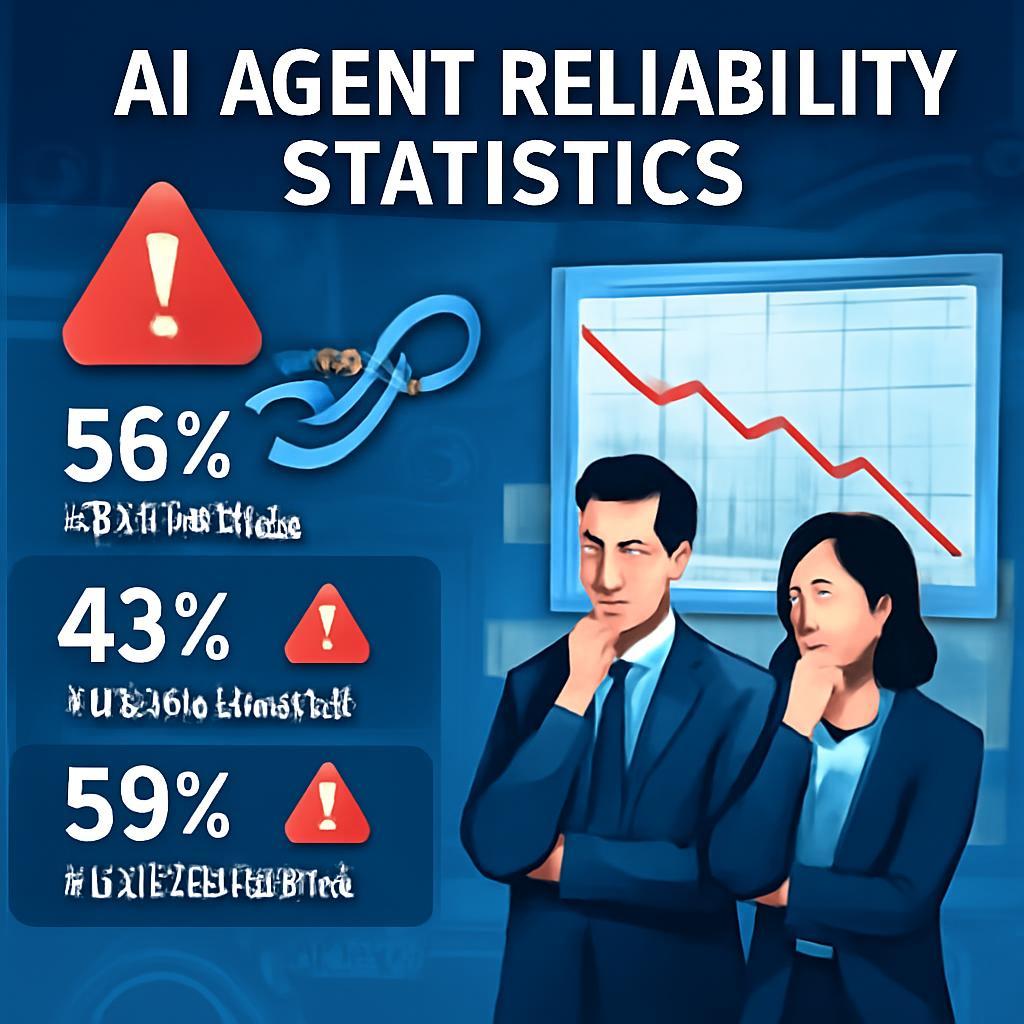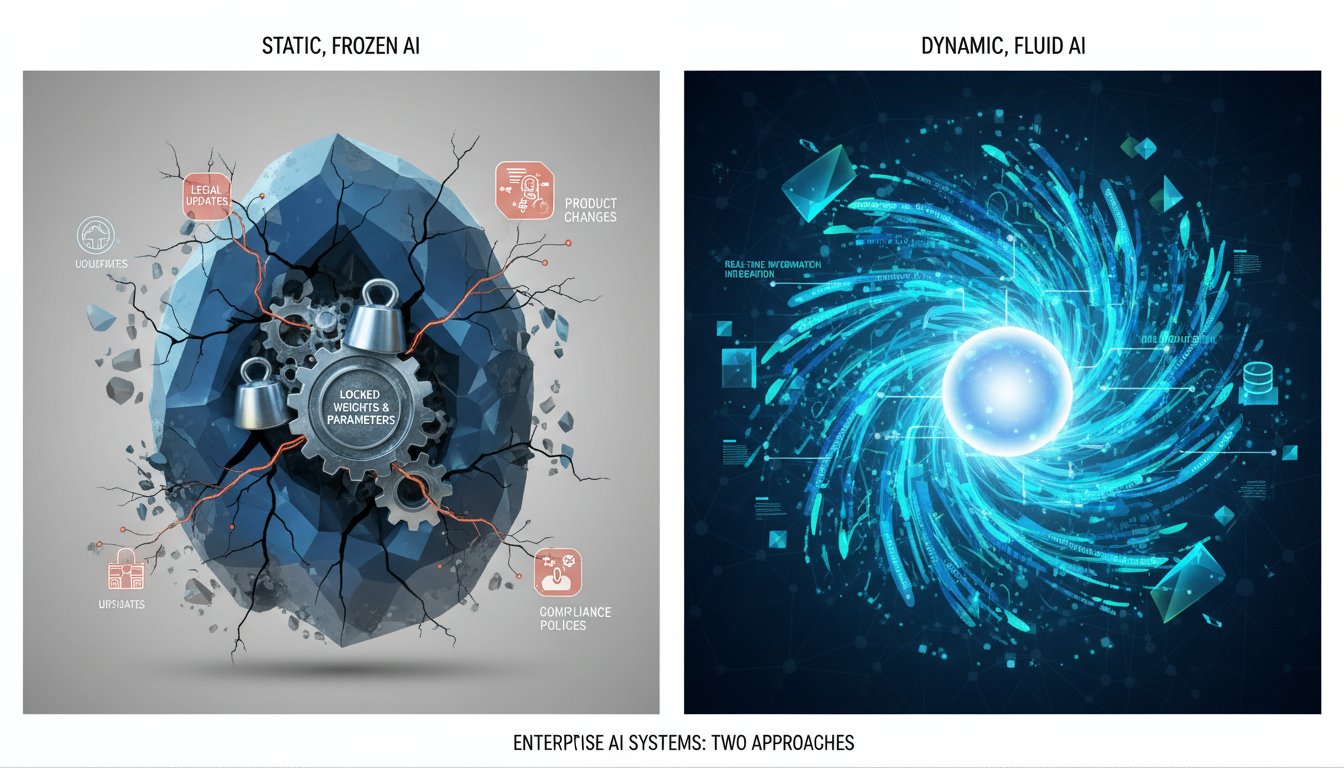Picture this: Your company just invested millions in an AI agent system that promised to revolutionize customer service. The demo was flawless—agents answered complex queries, pulled relevant data instantly, and even handled edge cases with surprising sophistication. Six months later, your support tickets have doubled, customer satisfaction has plummeted, and your CTO is questioning every AI decision your company has made.
You’re not alone. According to recent enterprise surveys, 73% of AI agent deployments fail to meet reliability expectations within their first year. The culprit isn’t the underlying AI technology—it’s the infrastructure supporting these agents that’s fundamentally broken.
While the AI community celebrates breakthrough after breakthrough, from OpenAI’s o3-pro to Anthropic’s contextual retrieval advances, enterprise leaders are grappling with a harsh reality: the gap between AI agent demos and production reliability is widening, not shrinking. This isn’t a technology problem—it’s an architecture problem that most organizations are approaching completely wrong.
In this deep dive, we’ll expose the hidden infrastructure challenges that are sabotaging AI agent reliability, reveal why traditional monitoring approaches are failing, and provide a blueprint for building truly reliable enterprise AI systems. By the end, you’ll understand exactly why your AI agents are unreliable and how to fix it before your next deployment becomes another cautionary tale.
The Invisible Infrastructure Crisis Behind AI Agent Failures
When Dylan Patel, a leading AI infrastructure expert, spoke at VB Transform 2025, he delivered a sobering reality check: “The primary challenge for enterprises isn’t the AI agents themselves but creating the robust, secure, and governable infrastructure necessary to manage a digital workforce.”
This infrastructure crisis manifests in three critical ways that most organizations completely overlook:
The Data Retrieval Reliability Gap
Traditional RAG systems treat data retrieval as a solved problem. Vector similarity search returns the “most relevant” documents, and the AI agent proceeds with whatever it receives. But here’s what enterprise data teams have discovered: vector databases fail silently.
Consider a financial services company that deployed an AI agent to handle investment queries. The agent performed flawlessly during testing with clean, curated data. In production, however, the vector database began returning outdated regulatory documents due to embeddings drift—a phenomenon where document representations slowly shift over time as the underlying model parameters change.
The result? The AI agent confidently provided investment advice based on superseded regulations, creating massive compliance risks the company only discovered during a routine audit three months later.
This isn’t an edge case. A recent study by enterprise AI practitioners found that 67% of production RAG systems experience significant retrieval accuracy degradation within 90 days of deployment due to:
- Embedding model drift affecting similarity calculations
- Data ingestion pipeline failures creating knowledge gaps
- Index corruption during high-volume operations
- Context window limitations causing information truncation
The Agent Orchestration Reliability Problem
Modern AI agents don’t operate in isolation—they’re part of complex orchestration workflows that involve multiple models, APIs, and data sources. Every additional component exponentially increases failure points.
Andrew Ng highlighted this challenge at VB Transform 2025: “We’re seeing an ‘Agentic Infrastructure Gap’ where promising demos in research labs struggle to translate to enterprise deployment due to security, governance, and orchestration challenges.”
The mathematics are stark. A simple AI agent workflow involving:
– Document retrieval (99.9% uptime)
– LLM inference (99.5% uptime)
– External API calls (99.0% uptime)
– Response formatting (99.9% uptime)
Results in an overall system reliability of just 98.3%—meaning nearly two hours of downtime every week.
Enterprise teams are discovering that traditional application monitoring tools completely miss AI-specific failure modes:
– Silent hallucinations that produce plausible but incorrect responses
– Context poisoning where malicious inputs corrupt agent memory
– Cascading failures where one agent’s error propagates through multi-agent workflows
– Resource exhaustion from poorly optimized prompt chains
The Observability Blindness Challenge
Perhaps most critically, existing monitoring solutions designed for traditional applications provide virtually no visibility into AI agent behavior. You can monitor CPU usage and response times, but you can’t monitor reasoning quality or factual accuracy.
This observability gap creates a dangerous situation where AI agents appear to be functioning normally while quietly producing unreliable outputs. Enterprise teams report spending 40-60% of their AI operations time manually auditing agent responses because they have no automated way to detect reliability issues.
Why Traditional Reliability Approaches Fail for AI Agents
Most enterprise teams approach AI agent reliability the same way they handle traditional software systems—through testing, monitoring, and incident response. This approach is fundamentally inadequate for AI systems that exhibit probabilistic rather than deterministic behavior.
The Testing Paradigm Mismatch
Traditional software testing relies on predictable input-output relationships. Give the same input, get the same output. AI agents violate this fundamental assumption.
Even with temperature settings at zero, AI agents can produce different responses due to:
– Model version updates changing underlying behavior
– Context window variations affecting reasoning paths
– Token limit constraints truncating responses inconsistently
– Retrieval randomness in vector similarity ties
Enterprise teams attempting to use traditional testing frameworks report test case maintenance overhead that exceeds 300% of development time. Every model update potentially invalidates existing test expectations.
The Monitoring Inadequacy Problem
Standard application monitoring focuses on system health metrics—response time, error rates, throughput. These metrics tell you nothing about AI agent reliability.
Consider these scenarios that traditional monitoring completely misses:
– An agent consistently retrieves irrelevant documents but responds quickly
– An agent provides accurate information but violates company policy
– An agent handles 99% of queries correctly but fails catastrophically on edge cases
– An agent’s reasoning quality degrades slowly over time due to context pollution
You need AI-native observability that monitors reasoning quality, not just system performance.
The Incident Response Complexity
When traditional software fails, the failure mode is usually clear: crashed processes, network timeouts, database locks. AI agent failures are often subtle and contextual.
An enterprise customer support team discovered their AI agent was providing increasingly aggressive responses to frustrated customers. Traditional monitoring showed normal operation—response times were fast, error rates low, customer queries were being answered. The issue only emerged when customer satisfaction scores plummeted over several weeks.
The root cause? The agent’s training data contained customer service interactions that became more assertive under stress, and production interactions were triggering this learned behavior pattern. No traditional monitoring tool could have detected this failure mode.
The AgenticOps Solution: Building Reliability-First AI Infrastructure
The solution to AI agent reliability isn’t better AI models—it’s AgenticOps: a new operational discipline specifically designed for managing AI agent workflows in production.
Implementing Multi-Layer Reliability Architecture
Reliable AI agent systems require redundancy and validation at every layer:
Data Layer Reliability:
– Implement dual-source retrieval with cross-validation
– Deploy real-time embedding quality monitoring
– Establish automated data freshness verification
– Create retrieval accuracy baselines and drift detection
Agent Layer Reliability:
– Deploy multi-model consensus for critical decisions
– Implement confidence scoring and uncertainty quantification
– Establish reasoning chain validation checkpoints
– Create agent behavior fingerprinting for anomaly detection
Orchestration Layer Reliability:
– Design circuit breakers for external API dependencies
– Implement graceful degradation for partial system failures
– Deploy chaos engineering for AI workflow resilience testing
– Establish automated failover between agent configurations
Building AI-Native Observability Systems
Reliable AI agents require observability systems designed specifically for probabilistic behaviors:
Semantic Monitoring:
– Deploy automated fact-checking against known knowledge bases
– Implement response quality scoring using specialized evaluation models
– Monitor semantic drift in agent responses over time
– Track reasoning consistency across similar queries
Behavioral Analysis:
– Establish agent personality consistency metrics
– Monitor for policy violation patterns in responses
– Track user satisfaction correlation with agent behavior
– Implement bias detection and fairness monitoring
Workflow Intelligence:
– Map agent decision trees for complex reasoning paths
– Monitor inter-agent communication quality in multi-agent systems
– Track resource utilization patterns for cost optimization
– Implement predictive failure detection based on usage patterns
Creating Reliability Governance Frameworks
Enterprise AI agent reliability requires governance frameworks that account for AI-specific risks:
Model Governance:
– Establish model version control and rollback procedures
– Implement staged deployment with reliability gates
– Create model performance regression testing
– Deploy automated model behavior drift detection
Data Governance:
– Implement data lineage tracking for retrieved information
– Establish data quality gates for agent training and inference
– Create automated data source reliability monitoring
– Deploy data access auditing for compliance requirements
Agent Governance:
– Establish agent behavior approval workflows
– Implement automated policy compliance checking
– Create agent interaction logging and audit trails
– Deploy role-based access controls for agent capabilities
Implementing Production-Ready Reliability: A Step-by-Step Blueprint
Building reliable AI agents requires a systematic approach that addresses infrastructure, monitoring, and governance simultaneously.
Phase 1: Infrastructure Hardening (Weeks 1-4)
Week 1-2: Multi-Source Retrieval Implementation
– Deploy primary and secondary vector databases
– Implement cross-validation between retrieval sources
– Establish retrieval quality scoring mechanisms
– Create automated fallback procedures for retrieval failures
Week 3-4: Agent Reliability Framework
– Deploy multi-model consensus for critical agent decisions
– Implement confidence thresholding and uncertainty quantification
– Establish reasoning chain validation checkpoints
– Create agent behavior baseline profiling
Phase 2: Observability Implementation (Weeks 5-8)
Week 5-6: Semantic Monitoring Deployment
– Deploy automated fact-checking against verified knowledge bases
– Implement response quality evaluation using specialized models
– Establish semantic consistency tracking across agent interactions
– Create policy violation detection and alerting
Week 7-8: Workflow Intelligence Systems
– Deploy agent decision tree mapping and analysis
– Implement predictive failure detection based on usage patterns
– Establish resource optimization monitoring
– Create inter-agent communication quality tracking
Phase 3: Governance Integration (Weeks 9-12)
Week 9-10: Model Governance Implementation
– Establish automated model version control and deployment gates
– Implement staged deployment with reliability validation
– Create model performance regression detection
– Deploy automated rollback procedures for reliability failures
Week 11-12: Operational Excellence
– Establish reliability incident response procedures
– Implement automated reliability reporting and dashboards
– Create reliability-focused agent training programs
– Deploy continuous reliability optimization workflows
Technology Stack Recommendations
For Multi-Source Retrieval:
– Primary: Pinecone or Weaviate for vector storage
– Secondary: Graph databases (Neo4j) for relationship context
– Validation: Custom similarity scoring with confidence thresholds
– Monitoring: Arize Phoenix for retrieval quality tracking
For Agent Orchestration:
– Framework: LangGraph for complex agent workflows
– Monitoring: LangSmith for agent behavior tracking
– Resilience: Custom circuit breakers with exponential backoff
– Scaling: Kubernetes with HPA for dynamic agent scaling
For Observability:
– Semantic Monitoring: Custom evaluation models using Anthropic Claude
– Behavioral Analysis: MLflow for agent performance tracking
– Workflow Intelligence: Custom analytics with Prometheus metrics
– Alerting: PagerDuty integration for reliability incidents
The Future of Reliable AI Agents: What’s Coming Next
The reliability challenges facing AI agents today are driving innovation across the entire AI infrastructure stack. Understanding these trends helps position your organization for long-term success.
Emerging Reliability Technologies
Self-Healing AI Systems:
New research from Anthropic and OpenAI focuses on AI agents that can detect and correct their own reliability issues. These systems use meta-cognition to monitor their reasoning quality and automatically adjust behavior when reliability metrics decline.
Formal Verification for AI:
Academic research is developing mathematical proof systems for AI agent behavior, allowing enterprises to formally verify that agents will behave reliably under specified conditions. While still early-stage, these approaches promise unprecedented reliability guarantees.
Quantum-Enhanced AI Reliability:
Quantum computing research suggests quantum error correction principles could apply to AI agent reliability, potentially eliminating certain classes of probabilistic failures through quantum superposition of agent states.
Industry Standardization Efforts
AgenticOps Standardization:
Major cloud providers are collaborating on standardized AgenticOps practices and tooling, similar to how DevOps practices were standardized in the 2010s. Expect comprehensive AgenticOps platforms from AWS, Google Cloud, and Azure by 2026.
AI Reliability Certification:
Industry groups are developing reliability certification standards for enterprise AI agents, providing third-party validation of agent reliability claims. This will become particularly important in regulated industries.
Open Source Reliability Tools:
The open source community is rapidly developing comprehensive reliability tooling for AI agents, reducing the barrier to implementing sophisticated reliability practices for smaller organizations.
Your Reliability Action Plan: From Chaos to Confidence
The gap between AI agent promise and reality isn’t closing—it’s widening. Organizations that master AI agent reliability now will have an unassailable competitive advantage as AI becomes central to business operations.
The evidence is overwhelming: traditional software reliability approaches are fundamentally inadequate for AI agents. The 73% failure rate for enterprise AI agent deployments isn’t a temporary growing pain—it’s a systemic problem that requires systematic solutions.
AgenticOps isn’t optional anymore. It’s the difference between AI agents that work in demos and AI agents that work in production. The companies that understand this distinction and invest in reliability-first AI infrastructure will dominate their markets. Those that don’t will become cautionary tales.
Start with the infrastructure hardening phase outlined above. Implement multi-source retrieval, deploy AI-native observability, and establish governance frameworks designed for probabilistic systems. Your future self—and your customers—will thank you.
Ready to build AI agents that actually work? Download our AgenticOps implementation toolkit and join the growing community of enterprises that have moved beyond AI demos to AI systems that deliver consistent, reliable value in production.




